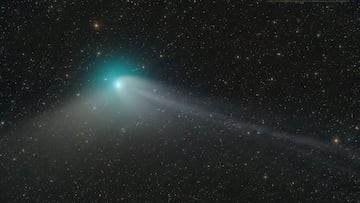Green Comet 2023: When and where are the best places to see it in the United States?
The “Green Comet”, last seen when Neanderthals walked the Earth, is at its easiest to see with the naked eye, but you’ll want someplace dark. Here’s where…

The “Green Comet”, technically known as C/2022 E3 (ZTF), is making its closest approach to Earth over the coming days. One of the most hoped for astronomical events, this particular comet last passed by our planet some 50,000 years ago, when both Neanderthals and Homo Sapiens walked the planet at the same time.
However, C/2022 E3 (ZTF) is quite small, so it won’t be as bright as other more famous comets that appear periodically in the night sky. This means that you will need to seek out some place with very little light pollution, and even then, due to its faintness will be difficult to see.
But, over the next few days, you may be able to see it with the naked eye, weather and sky conditions permitting, when it reaches its brightest. But it wouldn’t hurt to bring along a pair of binoculars or telescope. Here’s where you’ll have the best opportunity to see the celestial phenomenon.
The Green Comet will be high in the sky
Generally, only those who live in the Northern Hemisphere will have an opportunity to see this astronomical event. The path of the Green Comet is taking it over the Northern polar region where it will make its closet approach. As it moves farther away, more of the Earth’s inhabitants will be able to see it but as it gets farther away, it will become dimmer requiring more powerful instruments to aid in its viewing.
However, because it will be relatively near Polaris when it will be at its brightest, comet hunters, as long as they are in a fairly open space, will be able to look straight up into the sky to catch a glimpse during 1 and 2 February, when it will be easiest to see.
The Green Comet can be located by looking northwest, the path it is following, of the space between the North Star and the cup of the Big Dipper. In the morning hours, when you’ll have the best viewing as the Moon is waxing, getting bigger and brighter each day, it will be above and to the left of Polaris. You will be looking for a faint fuzzy ball in the sky, unfortunately the tail will not be visible, nor will you be able to see the green hue with the naked eye, and most likely neither with binoculars.
Find some place dark and early in the morning to see the comet
Key to being able to see the Green Comet unaided will be finding a place without light pollution. If you live in a city, it’s going to be pretty hard if not impossible. You’ll want to go out to the countryside where there little to no city lighting, even then without binoculars or a telescope it will be a challenge.
Farmlands, wilderness areas and parks will be your best bet. For the best stargazing in the night sky you may want to seek out an International Dark Sky Park located around the United States. These are areas that are specifically protected for their “scientific, natural, educational, cultural heritage, and/or public enjoyment.” They possess “an exceptional or distinguished quality of starry nights and a nocturnal environment.”
You can find a list of these places provided by the International Dark-Sky Association. Many of these places are publicly owned but they may be held by private landowners that “consent to the right of permanent, ongoing public access to specific areas” to receive the designation.
As the Moon is currently waxing, your best bet is to shoot for an early morning observation once the Moon has gone over the horizon and at least an hour and half before the Sun rises.






